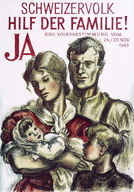
Unternavigation
On 25th November 1945, voters accepted a counterproposal of the Federal Council and Parliament for the popular initiative ‘For the Family’. The new Article 34quinquies enshrined family protection in the federal constitution and gave the Confederation the authority to create legislation in the area of family compensation funds, to introduce maternity insurance and to support the construction of housing and estates for the benefit of families. In contrast, the withdrawn initiative would have explicitly declared the family as the ‘foundation of state and society’ and demanded the Confederation to base its economic and social policy completely on the needs of families. It also involved the formation of compensation funds offering family or child allowances.
By launching the popular initiative ‘For the Family’, the Catholic Conservative Party entered the debate on post-war order with a socio-political draft based closely on Catholic social doctrine. Since their focus was placed on the ‘natural unit’ of the family and traditional gender roles, the initiative claimed to offer an alternative to the AHV advocated by the Socialists and the FDP. However, in view of falling birth rates and rising divorce rates, the notion of protecting the family gained momentum far beyond Catholics in the 1930s – such as in the Family Protection Commission of the Swiss Philanthropic Society (SGG), which included female representatives from the Union of Swiss Women’s Associations. Also, numerous family compensation funds had already been created before the end of the war.
The socio-political postulates accepted in January 1945 subsequently remained subordinate concerns of the welfare state. The family compensation funds were to a large extent regulated either on a private or cantonal level. It was not until 2006 that a federal act laid the groundwork for harmonization. Attempts to introduce maternity benefits failed in 1984, 1987 and 1999. A solution finally emerged in 2004 as part of the income compensation scheme.
Literatur / Bibliographie / Bibliografia / References: Schumacher Beatrice (2009), Familien(denk)modelle. Familienpolitische Weichenstellungen in der Formationsphase des Sozialstaats (1930–1945), in M. Leimgruber, M. Lengwiler (ed.), Umbruch an der ‚inneren Front‘. Krieg und Sozialpolitik in der Schweiz 1938–1948, 139–164, Zürich; Hauser Karin (2004), Die Anfänge der Mutterschaftsversicherung. Deutschland und Schweiz im Vergleich, Zürich; Studer Brigitte (1997), Familienzulagen statt Mutterschaftsversicherung? Die Zuschreibung der Geschlechterkompetenzen im sich formierenden Schweizer Sozialstaat, 1920–1945, Schweizerische Zeitschrift für Geschichte, 47, 151–170.
(12/2014)




